More small businesses are turning to pay-per-lead services these days. It sounds fair. You pay only when you get a lead, not for promises or long retainers. In a time when budgets are tight and every dollar has to show results, that idea feels safe.
But here’s the question: is it really the safer bet?
I’ve worked with business owners who loved the idea at first. Paying per lead sounded predictable. They saw numbers on a dashboard and thought: “finally, clear ROI.” Then came the surprises: low-quality contacts, shared leads, or long sales calls with people who were never ready to buy.
Pay-per-lead can work, but it’s not magic.
Like any system, it has limits, and not every business is built for it.
In this guide, we’ll look at how it works, when it makes sense, and when building your own in-house outreach might bring better results.
Why pay-per-lead is booming in 2025
Business owners today want numbers that make sense. Monthly retainers often feel risky: you pay thousands, wait for months, and still don’t know if real leads will come in.
That’s why the pay-per-lead model is gaining attention again. It sounds simple: no leads, no bill.
Markets in 2025 are unpredictable.
Ad costs rise each quarter. Competition grows across every search engine and social platform. Many small and mid-size companies can’t afford long testing periods, so they turn to models that promise quick, measurable outcomes.
Pay-per-lead fits that mood.
It gives a clear cost per lead and helps business owners plan their next campaigns with more confidence. For startups or lean marketing teams, this model feels like a breath of fresh air: less guessing, more data.
Still, the growing demand also attracts plenty of vendors. Some deliver great results, others cut corners. The rest of this guide will help you spot the difference before you invest.
How the pay-per-lead model works
At its core, pay-per-lead is simple. You pay a lead generation company only when it delivers leads that match your target audience. No monthly retainers, no fixed contracts. Each name or meeting has a set price.
Most lead generation agencies define a qualified lead as someone who fits your ideal customer profile and shows genuine buying intent. Some charge per contact (CPL), others per booked meeting (CPA). The cost usually depends on your industry, location, and lead quality.
For example, tech and software companies might pay between $50 and $500 per lead, while life sciences sales or financial sectors often pay more for exclusive leads.
Behind the scenes, a lead generation provider runs campaigns across multiple channels:
- cold email,
- LinkedIn,
- ads,
- and search engine optimization.
They use targeted lead databases and scoring tools to find prospective customers who match your criteria. Then they send these contacts directly to your sales teams or SDRs to keep the sales process moving.
Some firms run custom lead generation campaigns, adjusting filters like job title, company size, or region. Others use automation and behavioral data to create targeted sales leads at scale. A few even manage the full sales funnel, from outreach to appointment booking, acting like an outsourced inside sales partner.
It can sound like a dream: a ready pipeline without building your own system. But as we’ll see, the results depend on how carefully each campaign is managed and how much control you keep over the process.
Pros of pay-per-lead
The biggest draw of pay-per-lead services is the promise of results you can count. You pay for leads delivered, not for hours worked or meetings discussed. For many small and mid-size companies, that feels refreshing after long contracts with vague reporting.
When done well, these lead generation services can fill your pipeline with quality leads faster than building everything from scratch. Most lead generation companies already have the tools, data, and trained SDRs to run campaigns that reach your potential customers.
They work with proven lead generation strategies, using cold outreach, content, and social channels to keep the lead flow steady.
A strong vendor acts almost like an external sales development team. Some even run extensive appointment scheduling services, complete with US-based sales reps or a dedicated management team to handle outreach.
If your marketing budget is tight, paying per lead helps you control costs while testing new markets or audiences.
This model also brings speed.
You can start getting sales-ready leads within days instead of waiting months for inbound traction. It’s especially useful for the tech industry, where sales cycles are long and every opportunity counts.
The best agencies treat each project as comprehensive lead generation, running lead qualification, scoring, and lead nurturing before handing names to your sales executives.
Some even use behavioral and firmographic data to make targeted lead recommendations that fit your ideal client profile.
When it all clicks, PPL can support business growth with predictable numbers and less waste in marketing spend. You know exactly what you’re paying for, and that transparency is rare in marketing.
Cons and hidden costs
For all its appeal, pay-per-lead isn’t risk-free. Many business owners learn that the hard way.
The biggest challenge is lead quality. Not every contact is ready to buy, and not every agency takes time to qualify them properly.
Some lead generation companies focus on quantity, not fit. You might receive dozens of names, but only a few turn into real conversations. When that happens, your lead price stops feeling predictable and starts to rise.
Then there’s the issue of control.
You depend on an external lead generation platform and their sales professionals to reach your target audience. You don’t see how they create leads or what messaging they use. That means your brand voice, values, and long-term reputation sit in someone else’s hands.
Shared or recycled leads are another hidden problem.
Some lead generation specialists sell the same contacts to multiple clients, which means your SDRs and sales executives might be calling the same people as your competitors. That makes it harder to build trust and hurts conversion rates.
Even if you get a batch of valuable leads, the follow-up process still depends on your own team. Without proper lead scoring, nurturing, and timely responses, much of the money you spend can disappear.
Finally, while the upfront costs look light, long-term customer acquisition costs can grow fast. The more you rely on one global outsourced inside sales partner, the less you learn about what works for your own market.
Over time, you pay for the same lessons again and again.
In short, PPL can fill gaps quickly, but it rarely replaces the need for your own sales and marketing strategies. For most growing teams, a balance between outsourced help and internal learning brings stronger results.
Top pay-per-lead companies
There are dozens of agencies claiming to produce high-quality leads, but a few names come up often when business owners look for predictable results.
Each of these companies has a slightly different approach, pricing model, and industry focus.
Let’s check them out together:
1. Belkins
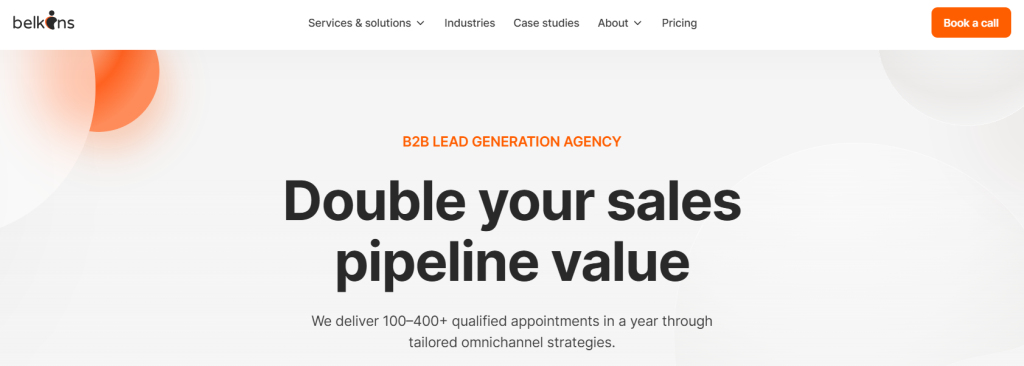
Belkins is one of the most recognized B2B lead generation agencies in the United States, known for its hands-on approach and consistent results.
Since 2017, it has helped over a thousand companies across 50+ industries build stronger pipelines through a mix of cold email outreach, LinkedIn prospecting, cold calling, and appointment setting.
What makes Belkins different from many other lead generation companies is how personal their process feels. Each client gets a tailored go-to-market plan built around their specific goals, industry, and buyer personas.
A dedicated Center of Excellence team, including a strategist, account manager, SDR, copywriter, and email tech expert, works together to manage every part of the campaign. This structure lets them generate high quality leads without losing the human touch.
Their campaigns follow a clear rhythm.
- Within 14 days, Belkins launches your outbound system.
- Within the first month, most clients start seeing booked meetings appear on their calendars.
The company reports annual outcomes of 100-400+ qualified appointments for clients – results backed by a 4.9 Clutch rating and 4.8 G2 score.
Belkins also supports clients through sales enablement and lead nurturing, helping bridge the gap between marketing and sales teams. They don’t just hand off contacts. They work on conversion strategies, lead research, and even HubSpot CRM consulting to strengthen your internal sales process.
The company’s omnichannel appointment setting approach includes multiple touchpoints:
- cold email,
- intent-based calling,
- SMS,
- WhatsApp,
- and paid ads.
This helps clients engage prospects at the right moment while keeping campaigns fresh and scalable.
For small and mid-sized businesses, Belkins acts as both a growth partner and a training ground. Its lead generation training and account-based marketing programs help teams learn how to build sustainable systems long after a campaign ends.
Clients across tech, SaaS, logistics, and healthcare sectors often mention faster deal closures and more stable pipelines after working with them.
2. CIENCE
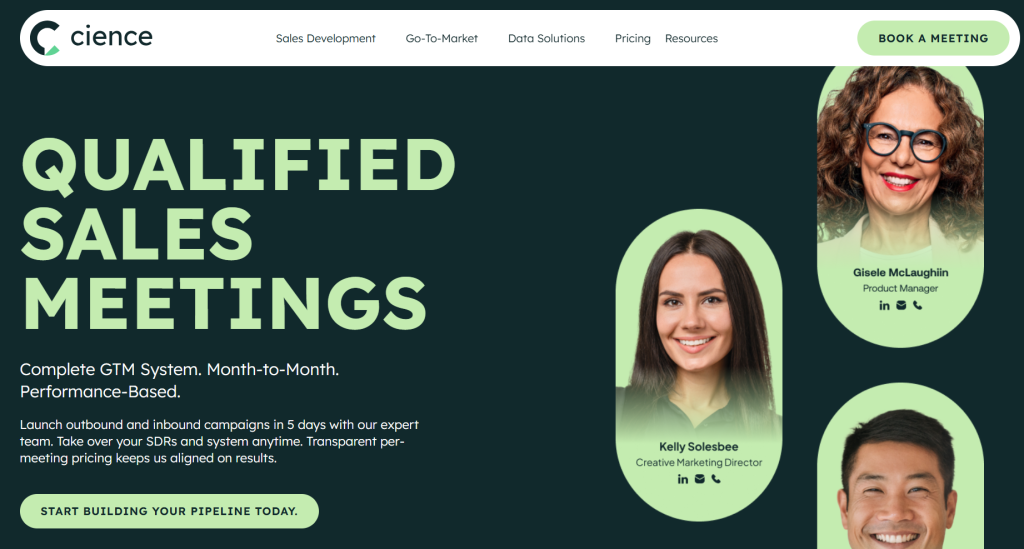
CIENCE is one of the best-known names among lead generation companies, especially for businesses that need scale and precision together.
The company combines human expertise with automation, using AI to support its team of trained SDRs and sales professionals. This hybrid setup helps clients reach large audiences fast while keeping messages personal.
Its model goes far beyond standard outreach.
CIENCE runs sales development programs, builds go-to-market plans, and delivers both outbound and inbound SDR services. Clients can launch new campaigns within a few days and pay on a per-meeting or per-lead basis.
The service works month-to-month, which makes it attractive for companies testing new markets or products.
What makes CIENCE stand out is its AI and human collaboration. AI handles personalization, timing, and analytics, while humans manage tone, targeting, and relationships.
This balance keeps engagement high and helps teams generate high quality leads that are more likely to convert.
The company’s data solutions division also plays a big part.
It runs custom research, data enrichment, and segmentation, helping clients reach the right target audience with each campaign. Local and regional teams add another layer and tailor outreach for different markets across North America, Europe, and beyond.
With Clutch, UpCity, and GoodFirms ratings above 4.5 stars, CIENCE is trusted by both startups and enterprises. Clients use it when they need structured systems that can produce leads at scale without building everything internally.
3. Martal Group
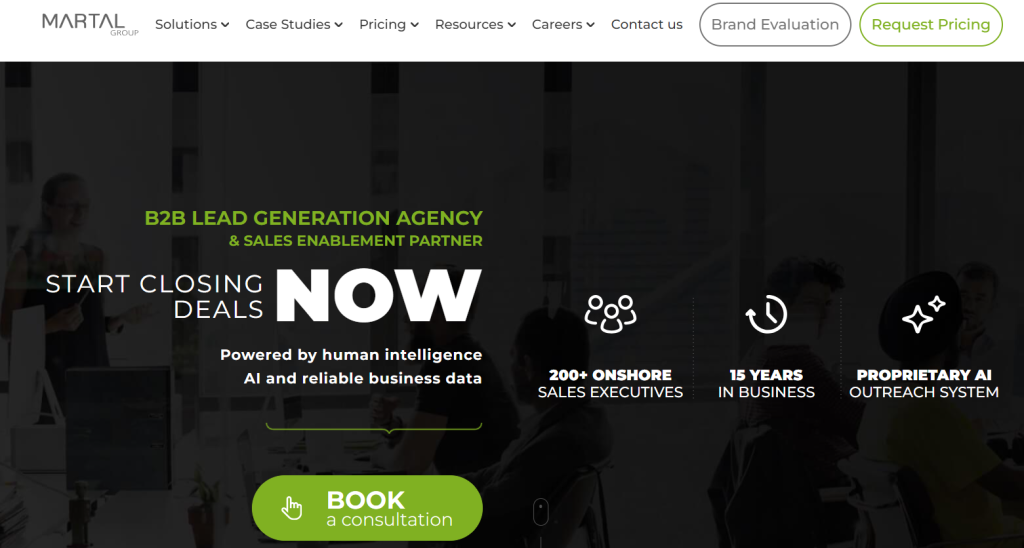
Martal Group has built a strong name in the B2B lead generation space with its hybrid approach: mixing human expertise, AI-driven targeting, and real sales experience.
With more than 15 years in business and a team of 200+ onshore sales executives across the U.S., Canada, Europe, and LATAM, Martal bridges the gap between traditional outreach and modern automation.
The company runs:
- outbound lead generation,
- inbound marketing,
- appointment setting,
- and sales outsourcing services under one roof.
Their AI sales platform powers daily outreach across multiple channels: cold email, LinkedIn, and phone. All while human teams personalize each message based on buyer intent and industry context.
That balance helps them generate high quality leads and build predictable pipelines for both startups and enterprise clients.
Martal’s sales professionals also act as an extension of your internal team.
They handle early prospecting, qualification, and scheduling so your in-house staff can focus on closing deals. Every client gets a dedicated management team and access to detailed performance tracking through custom dashboards.
What sets Martal apart from other lead generation companies is its reach and versatility. The firm supports dozens of industries, from SaaS, fintech, and cybersecurity to logistics, healthcare, and manufacturing.
Their campaigns adapt to local markets, with native-speaking reps in key regions and data-driven insights that pinpoint companies searching for products like yours.
The company’s process is clear:
- build a target list,
- engage with tailored messaging,
- measure results through KPIs,
- and scale based on proven ROI.
Martal even publishes its average monthly funnel: from 3,000-5,000 prospects targeted to 20-30 qualified leads per client. It really shows the kind of transparency that’s rarely seen in this field.
With high client satisfaction and 4.9+ ratings on Clutch, Martal continues to position itself as a sales enablement partner rather than just another vendor.
Its mix of technology, sales experience, and regional presence makes it one of the most trusted choices for businesses ready to generate leads in-house with expert guidance or fully outsource for faster growth.
4. Leadium
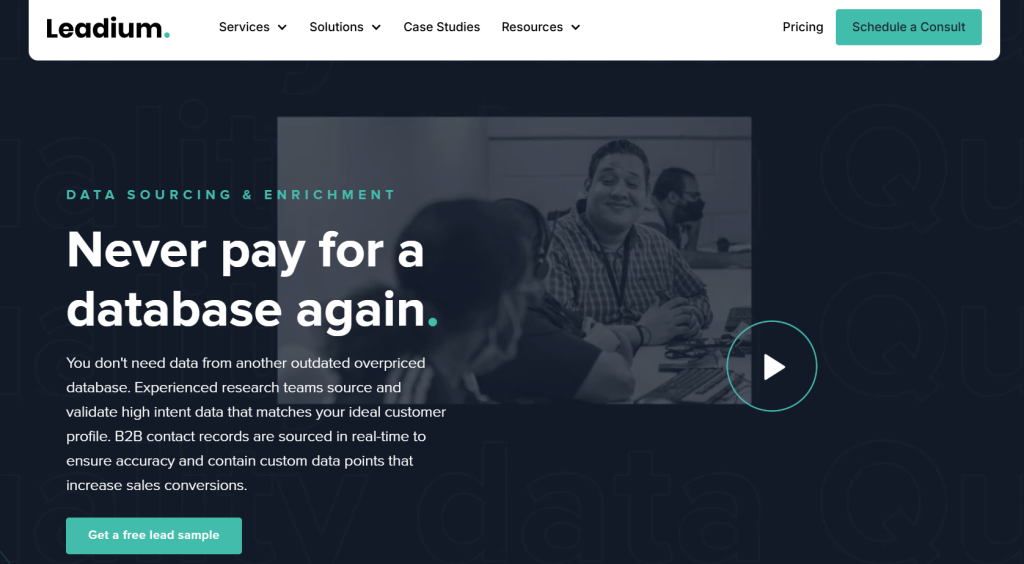
Leadium stands out for its data-driven precision and research-based approach to generating high quality leads.
Unlike many other lead generation companies, it doesn’t rely on outdated databases. Instead, Leadium runs a full data sourcing and enrichment process through dedicated research teams who source and validate contacts in real time.
This company focuses on accuracy and depth.
Each contact record is checked through a multi-step process that includes verification, channel optimization, and lead scoring.
The result is curated data lists tailored to a client’s ideal customer profile. That attention to detail helps businesses start more qualified conversations and run effective lead generation campaigns.
Leadium’s services go beyond list building.
Its SDRs and sales executives also run appointment-setting programs and manage outreach through email, phone, and LinkedIn.
That mix of human research and automation gives clients a full picture of their addressable market and helps them produce leads that match real buying intent.
The platform works well for SaaS, tech, and service-based firms that need verified, sales-ready leads at scale.
Combined with its customer success firm structure and trained data teams, Leadium delivers a system built for accuracy and long-term business growth.
When PPL makes sense (and when it doesn’t)
Pay-per-lead can work well, but only if the timing and structure of your business fit it. It’s not a one-size-fits-all model.
- It makes sense when you already have a clear sales process and know exactly who your best customers are.
- If your sales team can nurture leads fast and close deals with confidence, PPL helps you scale.
- You can treat it as an add-on, also known as a quick way to test new markets while keeping your main lead generation efforts steady.
- It’s also useful for companies with seasonal demand. You can turn campaigns on and off depending on your workload or budget. That flexibility can help you keep your pipeline full without hiring extra staff.
But PPL stops working when your sales and marketing strategies aren’t ready to handle the volume. If your internal systems can’t track, score, or follow up, you’ll waste even high quality leads. You might also struggle when leads don’t match your market. Many other lead generation companies offer shared or outdated contacts, leaving your team chasing people with no buying intent.
For early-stage businesses or teams still learning how to generate leads in-house, it’s often smarter to start small: build your own process, test messages, and learn what works. Once you know what a good lead looks like, you can use PPL services with more control and better results.
So, before signing any deal, ask yourself: do I need quick help, or do I want to own my system? The answer tells you whether pay-per-lead fits your current stage or just fills a short-term gap.
Smarter alternative: running outreach in-house with Woodpecker
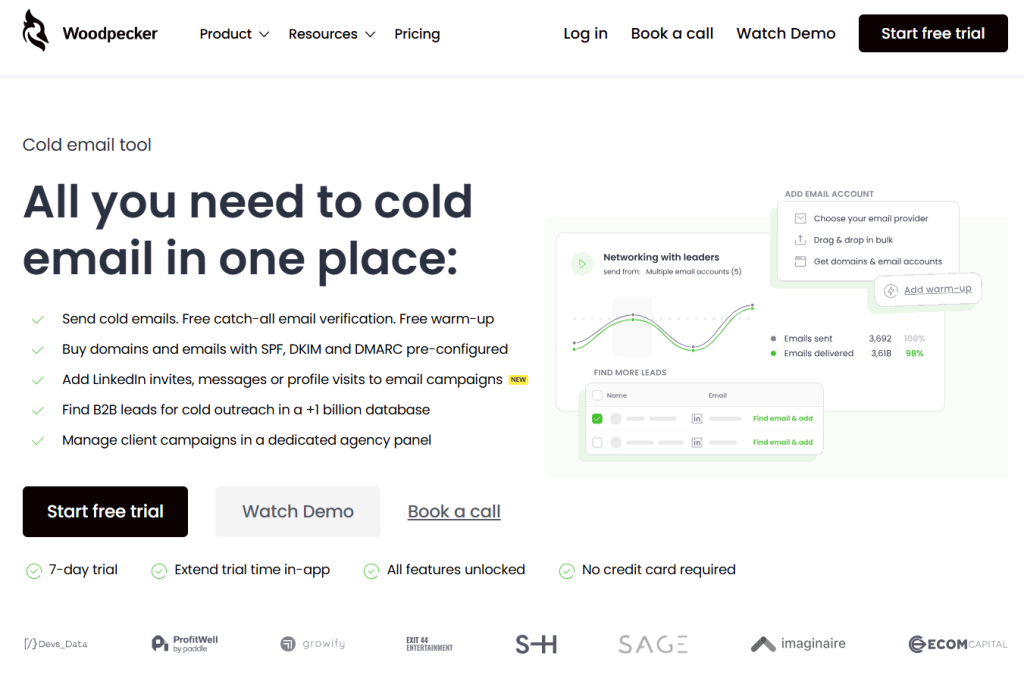
If you’ve ever thought about building your own outreach system instead of paying per lead, you don’t need a full sales department to make it work. With tools like Woodpecker, small and mid-size teams can run fully personalized cold email and LinkedIn campaigns. All from one dashboard.
Here’s how it works in practice. You start by connecting your domain and inbox. Woodpecker automatically sets up SPF, DKIM, and DMARC records to protect your sender reputation. Then it warms up your email account before sending any campaigns. It’s a built-in feature that keeps your messages out of spam folders.
Once ready, you can build your contact list directly inside the app using the B2B Lead Finder, which gives access to over one billion verified contacts. No extra data purchases or manual exports. You can even check every address with free catch-all verification to make sure each email is valid before sending.
Next, you write your message sequence. Woodpecker’s AI writing assistant can help you draft short, personal cold emails in seconds. Then you can test up to five versions at once with A/B testing to see which one performs best. Every campaign includes smart conditional follow-ups, so if a lead clicks or replies, they automatically stop receiving more messages, saving you time and protecting your domain.
To reach prospects on multiple channels, you can add LinkedIn invites, messages, or profile visits directly into your email campaign. This turns your outreach into a small omnichannel system without switching tools.
Deliverability stays consistent thanks to Inbox Rotation, Adaptive Sending, and the Deliverability Monitor, which predicts sending issues before they happen.
If you manage outreach for several products or clients, the Agency Panel keeps everything in one place with white-label reports.
Many users praise Woodpecker for how easy it is to get started. As one G2 reviewer wrote, “Creating a campaign is very easy and intuitive.” Another said, “It automates the follow-up process and detects replies, making your job ten times easier.” Others highlight its reliability: “Woodpecker is the best cold mailing tool I use daily. It keeps the flow constant and saves hours each week.”
For small businesses, this setup costs less than hiring one SDR or signing a long retainer. Plans start at $20 per month, with a 7-day free trial that includes all features unlocked, no credit card required. Within an hour, you can create your first campaign, send your first batch, and start getting real replies.
That’s the real strength of running outreach in-house: full control over your tone, data, and follow-up. You own your system, learn from every response, and build long-term skills instead of paying for short-term leads.
And with Woodpecker doing the heavy lifting, your team can focus on what matters most: real conversations that grow your business.
Conclusion
Pay-per-lead looks simple at first glance. After all, you pay only when a lead appears. For many businesses, that’s enough to try it.
But as you’ve seen, the model has layers. You trade control for speed, and you depend on someone else’s system to reach your audience.
If your sales and marketing strategies are strong and your team can nurture leads quickly, PPL can fill short-term gaps.
It’s helpful when you want to test new markets or balance seasonal demand. Just remember: not all leads are equal, and not every vendor focuses on high-quality leads.
For long-term growth, nothing beats learning how to generate leads in-house. When you build your own process, you understand what works and adjust faster to protect your brand.
That’s where Woodpecker stands out. It gives you the tools to reach the right people and keep improving your results without losing control or paying per contact.
So here’s the takeaway: pay-per-lead can start the fire, but your own outreach keeps it burning. Build your system with Woodpecker, learn from every campaign, and your pipeline will stay full. No matter how the market shifts next year.

